 Technology peripherals
Technology peripherals
 AI
AI
 AI solves college mathematics problems in a few seconds, achieves an accuracy rate of more than 80%, and also acts as a question teacher
AI solves college mathematics problems in a few seconds, achieves an accuracy rate of more than 80%, and also acts as a question teacher
AI solves college mathematics problems in a few seconds, achieves an accuracy rate of more than 80%, and also acts as a question teacher

Maybe the math test questions you took were machine-generated.
MIT students can easily solve mathematical topics such as multivariate calculus, differential equations, linear algebra, etc., but these But the machine learning model was stumped. Because machine learning models can only answer elementary or high school level math questions, and they don’t always find the right answer.
##Now, researchers from MIT, Columbia University, Harvard University and the University of Waterloo use small sample learning and OpenAI’s Codex to automatically synthesize programs and solve the problem in a few seconds. solved college mathematics problems and reached human level. The research was published in the Proceedings of the National Academy of Sciences (PNAS).
In addition, the model can explain the generated solutions and quickly generate new college mathematics problems. When the researchers showed these machine-generated questions to students, the students couldn't even tell whether the questions were generated by an algorithm or a human.
This research can also be used to streamline course content generation, which is especially useful for schools with thousands of students and massive open online courses (MOOCs). The system can also act as an online tutor, showing students the steps to solve math problems.

Paper address: https://www.pnas.org/doi/epdf/10.1073/pnas.2123433119
The method of this study combines three innovations:
- Unlike pre-training only on text, this study While pre-training on the text, fine-tuning is also performed on the code;
- Using small sample learning to synthesize the program can correctly solve mathematical problems;
- The research can solve problems, explain solutions, and generate new questions.
Examples of new questions generated by this research are as follows.
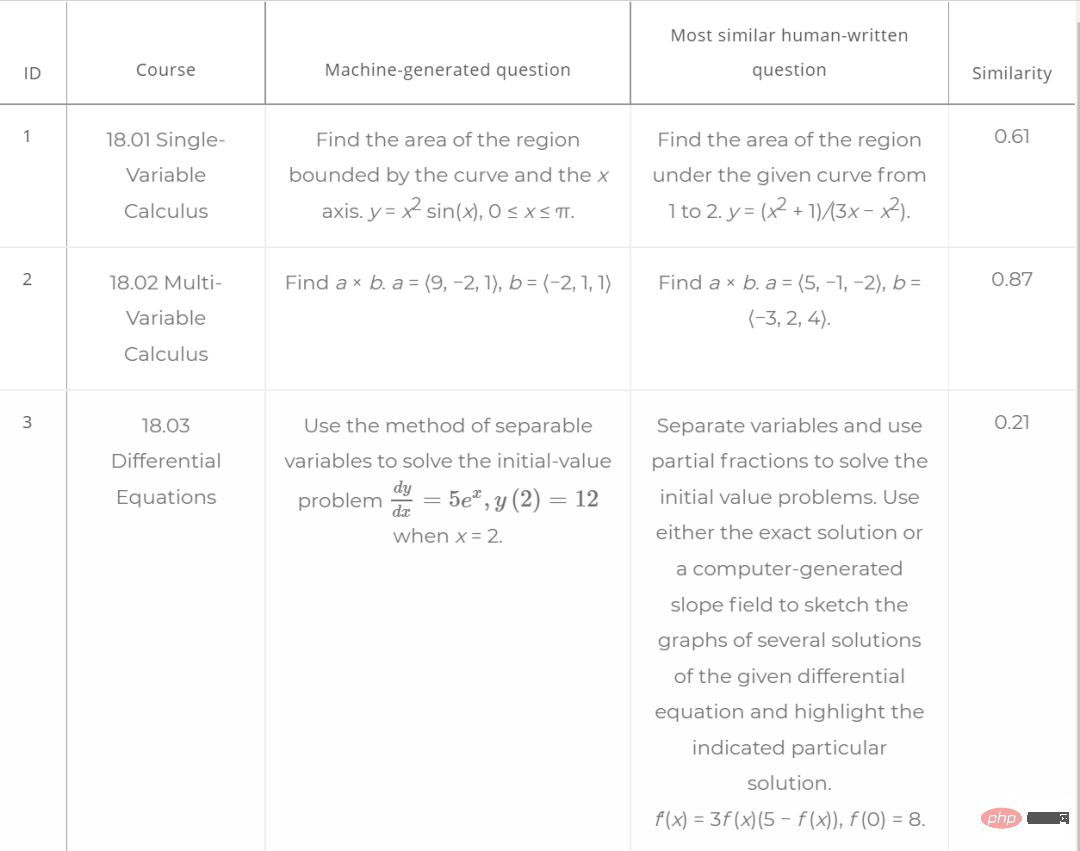 ##A model that can answer, solve and pose questions
##A model that can answer, solve and pose questions
The study randomly selected 25 problems from seven courses: MIT's 18.01 Single Variable Calculus, 18.02 Multivariable Calculus, 18.03 Differential Equations, 18.05 Introduction to Probability and Statistics, 18.06 Linear Algebra, 6.042 Mathematics for Computer Science, and COMS3251 Computational Linear Algebra from Columbia University.
For the MATH dataset, the study randomly sampled 15 questions from six topics in the dataset (Algebra, Counting and Probability, Intermediate Algebra, Number Theory, Preliminary Algebra, and Calculus) .
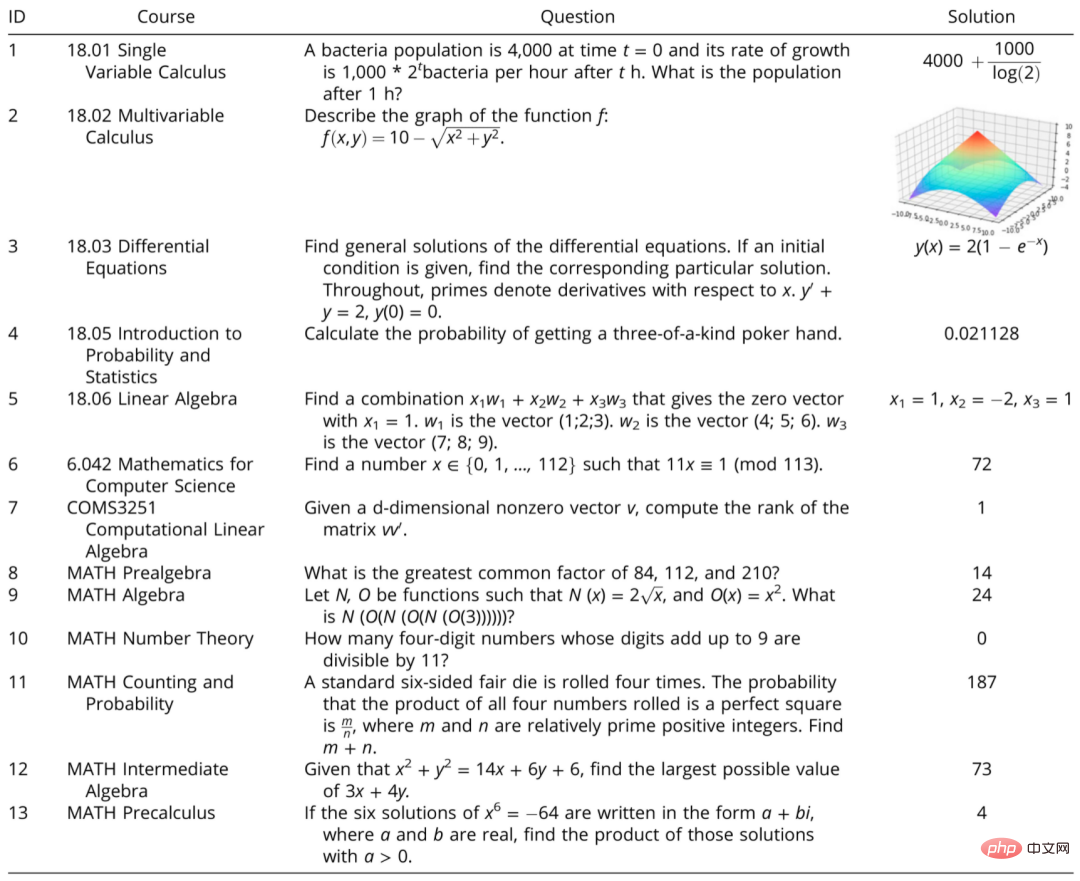
It is different from networks such as GPT-3 that are only pre-trained on text. They transformed these problems into programming tasks and applied program synthesis and few-shot learning techniques. Turning a mathematical problem into a programming task can be as simple as rewriting the problem of finding the distance between two points as writing a program to find the difference between two points.
It is worth mentioning that this research not only pre-trained Codex on text, but also fine-tuned the code so that it can generate programs for solving large-scale mathematical problems.
Pre-trained models display millions of code examples from online repositories. Because the model's training data includes millions of natural language words and millions of lines of code, it can learn relationships between snippets of text and snippets of code. As shown in the figure below, this study uses zero-shot and small-shot learning to automatically generate a program that can solve 81% of mathematical problems. They then use the Codex to interpret the resulting program. The generated program can output answers in many forms. For example, calculating and depicting the geometric shape of singular value decomposition (SVD) not only gives the correct answer, but also the corresponding explanation! Drori, one of the authors of the paper, explained that many mathematical problems can be solved using graphs or trees, but problems written in text are difficult to converted into this representation. However, because the model has learned the relationship between text and code, it can convert text questions into code by simply giving a few examples of question code and then running the code to answer the question. "When you ask questions using only text, it is difficult for machine learning models to give answers, even though the answer may be in the text. This work fills in the missing gap in code and program synthesis. Partly," Drori said. Drori also added that this work is the first to solve an undergraduate mathematics problem and improves accuracy from 8% to more than 80%. In fact, it is not always easy to convert mathematical problems into programming tasks. Some problems require researchers to add context so that neural networks can handle the problem correctly. A student will learn this background knowledge while taking the course, but neural networks do not have this background knowledge unless explicitly stated by the researcher. For example, they need to explain that the network in the text refers to a neural network and not a communication network. Or they may need to tell the model which programming package to use. They may also need to provide certain definitions, for example in a question about playing cards, they may need to tell the model that each deck contains 52 cards. The study automatically feeds these programming tasks, along with included context and examples, into a pre-trained and fine-tuned neural network, which outputs a neural network that typically produces the correct answer. program of. More than 80% of the questions were correct. The researchers also used their model to generate questions, by giving a neural network a series of mathematical questions about a topic and then letting it create a new question. For example, there is the problem of quantum detection of horizontal and vertical lines, which creates a new problem of quantum detection of diagonals. So it's not just creating new problems by replacing values and variables in existing problems. The researchers tested the machine-generated questions by showing them to college students. The researchers randomly gave students 10 problems from an undergraduate mathematics course; five were created by humans and five were generated by machines. Students were unable to tell whether the machine-generated questions were generated by an algorithm or a human, and they gave similar ratings on the difficulty and appropriateness of the course. However, Drori noted that this work is not intended to replace human professors. "Now the accuracy has reached 80%, but it will not reach 100%. Every time you solve a problem, someone will ask a harder problem. But this work It opens up the field for people to start using machine learning to solve increasingly difficult problems. We think this will have a huge impact on higher education," Drori said. The research team is excited about the success of their approach and is extending the work to handle mathematical proofs. They also plan to address some limitations. Currently, the model cannot use a visual component. Answering questions also fails to solve problems that are difficult to compute due to computational complexity. In addition to overcoming these obstacles, the research also aims to scale the model to hundreds of courses. With these courses, they will generate more data to increase automation and provide insights into course design and curriculum. 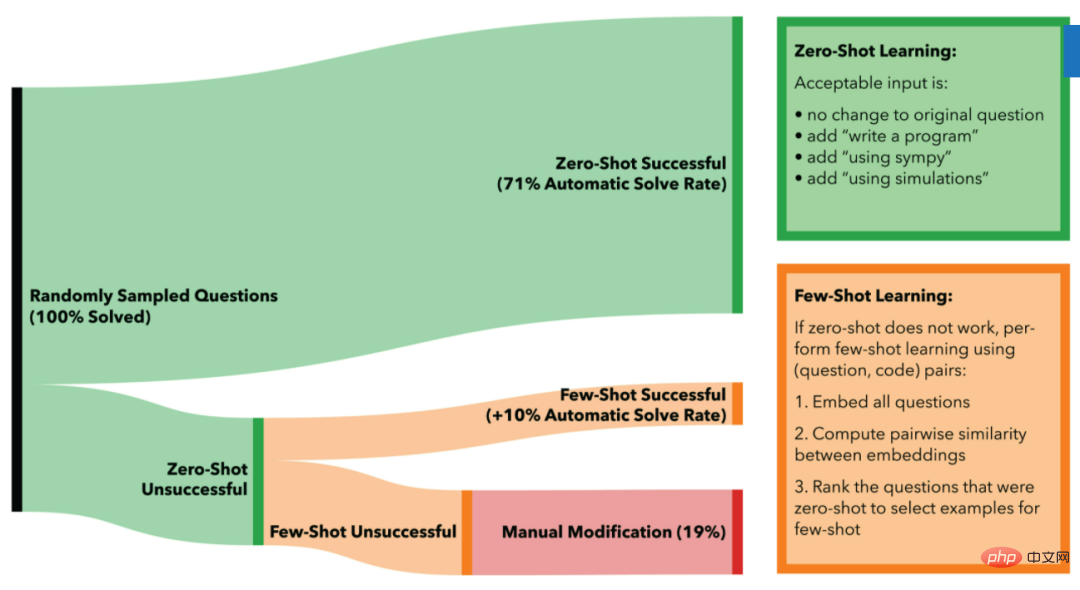
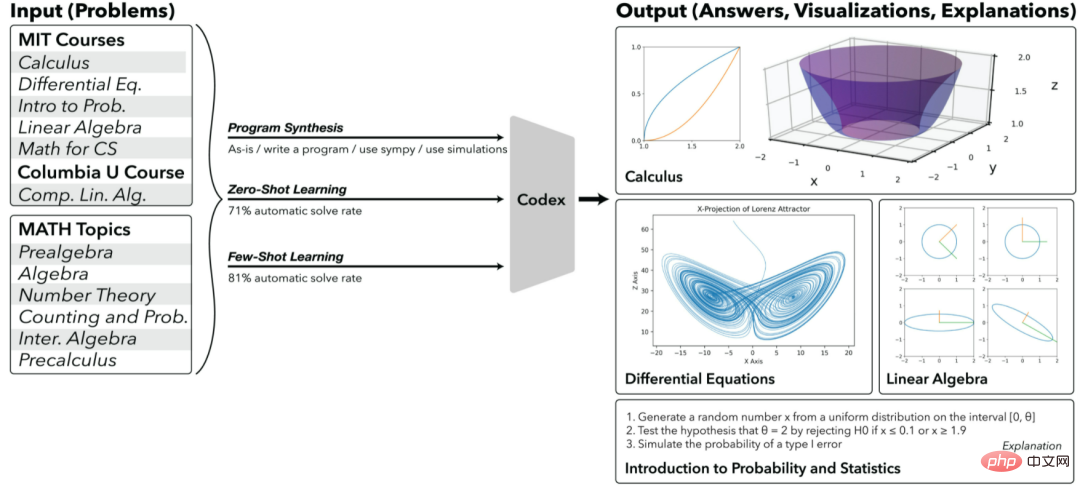 Apply neural networks with OpenAI Codex to solve, interpret and generate mathematical problems.
Apply neural networks with OpenAI Codex to solve, interpret and generate mathematical problems. Add context
Human-Asked Questions vs. Machine-Generated Questions
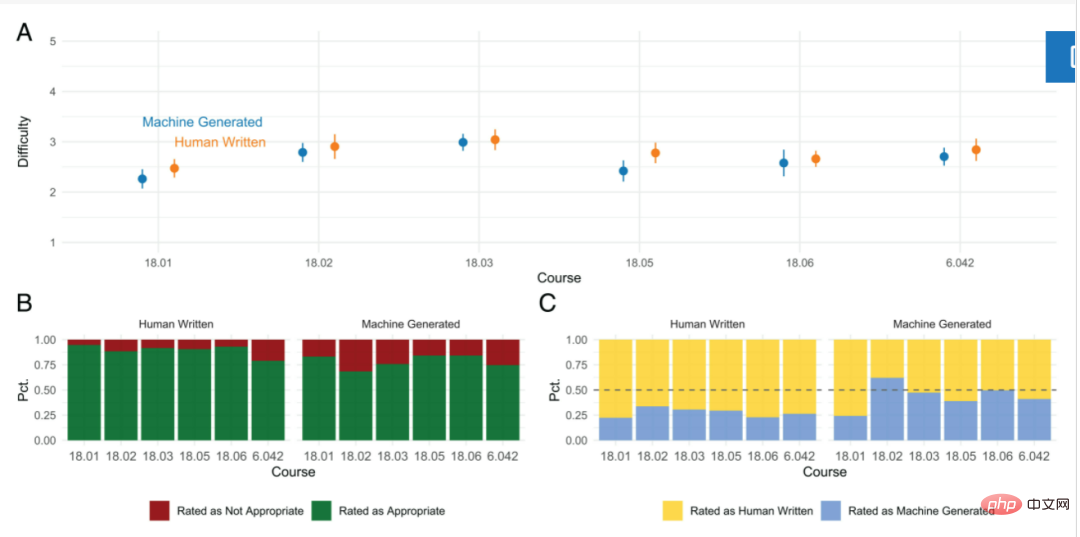
The above is the detailed content of AI solves college mathematics problems in a few seconds, achieves an accuracy rate of more than 80%, and also acts as a question teacher. For more information, please follow other related articles on the PHP Chinese website!

Hot AI Tools

Undresser.AI Undress
AI-powered app for creating realistic nude photos

AI Clothes Remover
Online AI tool for removing clothes from photos.

Undress AI Tool
Undress images for free

Clothoff.io
AI clothes remover

Video Face Swap
Swap faces in any video effortlessly with our completely free AI face swap tool!

Hot Article

Hot Tools

Notepad++7.3.1
Easy-to-use and free code editor

SublimeText3 Chinese version
Chinese version, very easy to use

Zend Studio 13.0.1
Powerful PHP integrated development environment

Dreamweaver CS6
Visual web development tools

SublimeText3 Mac version
God-level code editing software (SublimeText3)

Hot Topics
 1386
1386
 52
52
 How to solve the complexity of WordPress installation and update using Composer
Apr 17, 2025 pm 10:54 PM
How to solve the complexity of WordPress installation and update using Composer
Apr 17, 2025 pm 10:54 PM
When managing WordPress websites, you often encounter complex operations such as installation, update, and multi-site conversion. These operations are not only time-consuming, but also prone to errors, causing the website to be paralyzed. Combining the WP-CLI core command with Composer can greatly simplify these tasks, improve efficiency and reliability. This article will introduce how to use Composer to solve these problems and improve the convenience of WordPress management.
 How to solve SQL parsing problem? Use greenlion/php-sql-parser!
Apr 17, 2025 pm 09:15 PM
How to solve SQL parsing problem? Use greenlion/php-sql-parser!
Apr 17, 2025 pm 09:15 PM
When developing a project that requires parsing SQL statements, I encountered a tricky problem: how to efficiently parse MySQL's SQL statements and extract the key information. After trying many methods, I found that the greenlion/php-sql-parser library can perfectly solve my needs.
 How to solve complex BelongsToThrough relationship problem in Laravel? Use Composer!
Apr 17, 2025 pm 09:54 PM
How to solve complex BelongsToThrough relationship problem in Laravel? Use Composer!
Apr 17, 2025 pm 09:54 PM
In Laravel development, dealing with complex model relationships has always been a challenge, especially when it comes to multi-level BelongsToThrough relationships. Recently, I encountered this problem in a project dealing with a multi-level model relationship, where traditional HasManyThrough relationships fail to meet the needs, resulting in data queries becoming complex and inefficient. After some exploration, I found the library staudenmeir/belongs-to-through, which easily installed and solved my troubles through Composer.
 How to solve the problem of PHP project code coverage reporting? Using php-coveralls is OK!
Apr 17, 2025 pm 08:03 PM
How to solve the problem of PHP project code coverage reporting? Using php-coveralls is OK!
Apr 17, 2025 pm 08:03 PM
When developing PHP projects, ensuring code coverage is an important part of ensuring code quality. However, when I was using TravisCI for continuous integration, I encountered a problem: the test coverage report was not uploaded to the Coveralls platform, resulting in the inability to monitor and improve code coverage. After some exploration, I found the tool php-coveralls, which not only solved my problem, but also greatly simplified the configuration process.
 How to solve the complex problem of PHP geodata processing? Use Composer and GeoPHP!
Apr 17, 2025 pm 08:30 PM
How to solve the complex problem of PHP geodata processing? Use Composer and GeoPHP!
Apr 17, 2025 pm 08:30 PM
When developing a Geographic Information System (GIS), I encountered a difficult problem: how to efficiently handle various geographic data formats such as WKT, WKB, GeoJSON, etc. in PHP. I've tried multiple methods, but none of them can effectively solve the conversion and operational issues between these formats. Finally, I found the GeoPHP library, which easily integrates through Composer, and it completely solved my troubles.
 Solve CSS prefix problem using Composer: Practice of padaliyajay/php-autoprefixer library
Apr 17, 2025 pm 11:27 PM
Solve CSS prefix problem using Composer: Practice of padaliyajay/php-autoprefixer library
Apr 17, 2025 pm 11:27 PM
I'm having a tricky problem when developing a front-end project: I need to manually add a browser prefix to the CSS properties to ensure compatibility. This is not only time consuming, but also error-prone. After some exploration, I discovered the padaliyajay/php-autoprefixer library, which easily solved my troubles with Composer.
 How to solve the problem of virtual columns in Laravel model? Use stancl/virtualcolumn!
Apr 17, 2025 pm 09:48 PM
How to solve the problem of virtual columns in Laravel model? Use stancl/virtualcolumn!
Apr 17, 2025 pm 09:48 PM
During Laravel development, it is often necessary to add virtual columns to the model to handle complex data logic. However, adding virtual columns directly into the model can lead to complexity of database migration and maintenance. After I encountered this problem in my project, I successfully solved this problem by using the stancl/virtualcolumn library. This library not only simplifies the management of virtual columns, but also improves the maintainability and efficiency of the code.
 git software installation tutorial
Apr 17, 2025 pm 12:06 PM
git software installation tutorial
Apr 17, 2025 pm 12:06 PM
Git Software Installation Guide: Visit the official Git website to download the installer for Windows, MacOS, or Linux. Run the installer and follow the prompts. Configure Git: Set username, email, and select a text editor. For Windows users, configure the Git Bash environment.



